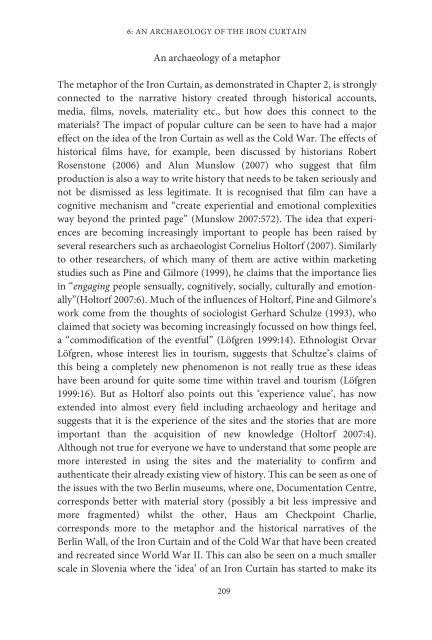1JZGauQ
1JZGauQ
1JZGauQ
Create successful ePaper yourself
Turn your PDF publications into a flip-book with our unique Google optimized e-Paper software.
6: AN ARCHAEOLOGY OF THE IRON CURTAIN<br />
An archaeology of a metaphor<br />
The metaphor of the Iron Curtain, as demonstrated in Chapter 2, is strongly<br />
connected to the narrative history created through historical accounts,<br />
media, films, novels, materiality etc., but how does this connect to the<br />
materials The impact of popular culture can be seen to have had a major<br />
effect on the idea of the Iron Curtain as well as the Cold War. The effects of<br />
historical films have, for example, been discussed by historians Robert<br />
Rosenstone (2006) and Alun Munslow (2007) who suggest that film<br />
production is also a way to write history that needs to be taken seriously and<br />
not be dismissed as less legitimate. It is recognised that film can have a<br />
cognitive mechanism and “create experiential and emotional complexities<br />
way beyond the printed page” (Munslow 2007:572). The idea that experiences<br />
are becoming increasingly important to people has been raised by<br />
several researchers such as archaeologist Cornelius Holtorf (2007). Similarly<br />
to other researchers, of which many of them are active within marketing<br />
studies such as Pine and Gilmore (1999), he claims that the importance lies<br />
in “engaging people sensually, cognitively, socially, culturally and emotionally”(Holtorf<br />
2007:6). Much of the influences of Holtorf, Pine and Gilmore’s<br />
work come from the thoughts of sociologist Gerhard Schulze (1993), who<br />
claimed that society was becoming increasingly focussed on how things feel,<br />
a “commodification of the eventful” (Löfgren 1999:14). Ethnologist Orvar<br />
Löfgren, whose interest lies in tourism, suggests that Schultze’s claims of<br />
this being a completely new phenomenon is not really true as these ideas<br />
have been around for quite some time within travel and tourism (Löfgren<br />
1999:16). But as Holtorf also points out this ‘experience value’, has now<br />
extended into almost every field including archaeology and heritage and<br />
suggests that it is the experience of the sites and the stories that are more<br />
important than the acquisition of new knowledge (Holtorf 2007:4).<br />
Although not true for everyone we have to understand that some people are<br />
more interested in using the sites and the materiality to confirm and<br />
authenticate their already existing view of history. This can be seen as one of<br />
the issues with the two Berlin museums, where one, Documentation Centre,<br />
corresponds better with material story (possibly a bit less impressive and<br />
more fragmented) whilst the other, Haus am Checkpoint Charlie,<br />
corresponds more to the metaphor and the historical narratives of the<br />
Berlin Wall, of the Iron Curtain and of the Cold War that have been created<br />
and recreated since World War II. This can also be seen on a much smaller<br />
scale in Slovenia where the ‘idea’ of an Iron Curtain has started to make its<br />
209




